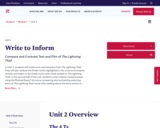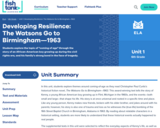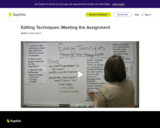In Unit 2, students continue reading the anchor text, Two Roads, starting at the conclusion of chapter 18, just as Pop is leaving Cal behind at Challagi Indian Industrial School. For the first time, Cal is on his own. For the first time, Cal is aware of his Creek heritage. As Cal begins his venture into student life at Challagi Indian Industrial School, students continue to track his character growth through the challenges he faces. With the plot developing and Cal’s character evolving, students are able to identify emerging themes, such as “Identities are complicated and conflicting, and tensions may exist between our different identities” and “It is critical to study indigenous histories so their contributions are not forgotten.” Discussions around the anchor text allow students a space to examine their own emerging and evolving identities, racially and socially.
To better understand how an author reveals theme, students examine the use of allusion, an artistic technique in which the author incorporates indirect references to some cultural touchstones with which the audience is likely familiar. Additionally, students analyze word connotation to understand the subtle way in which word choice conveys emotions or meaning. By studying the nuances of language, students develop as discerning readers, able to interpret both explicit and implicit messages.
For the mid-unit assessment, students read a new chapter of Two Roads and answer selected response and short constructed response questions about Cal’s point of view, how Cal is responding and changing throughout the plot, and emerging themes in the text. Students also write an objective summary of the chapter, identifying a possible theme and the details from the text that convey that theme.
In the second half of the unit, students finish reading the novel and discover that Cal, spurred by a premonition that Pop is in trouble, has run away from Challagi to find Pop in Washington DC. Cal’s vision was correct, and he arrives just as the Bonus Army is being forcibly removed from the capital. Having proven himself mature enough to handle these tough situations, Pop gives Cal the option of staying with him or returning to Challagi. Students begin their work with argument writing by gathering evidence for and against Cal returning to Challagi. As letters are a key text feature in the novel, students write a narrative letter to Possum, embodying the role of Cal, as they make the argument. Students will hone their argument-writing skills in Unit 3 when they write a literary argument essay. Letter writing in this unit is the vehicle through which students practice defending a side, while also being assessed on the extensive grammar instruction they receive in this unit.
Throughout Unit 2, students build knowledge and skills about pronoun case, person, and number; and correcting vague pronouns. Additionally, a variety of interactive and discussion-based activities help students to practice strategies for incorporative more variety into their sentence patterns to enhance meaning, engage reader interest, and add style. For the end of unit assessment, students write their narrative letter and then revise their work based on pronoun case, pronoun number and person, vague pronouns, and sentence variety. An alternative end of unit assessment requires students to read a narrative letter and answer selected response and short constructed response questions about pronoun case, pronoun number and person, vague pronouns, and sentence variety.



